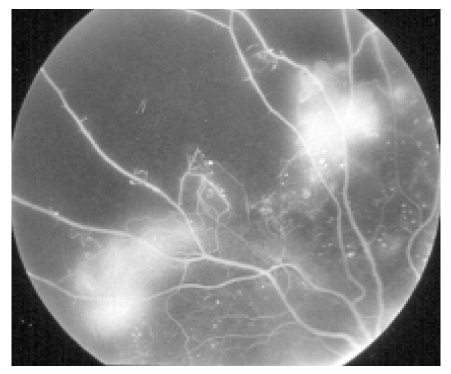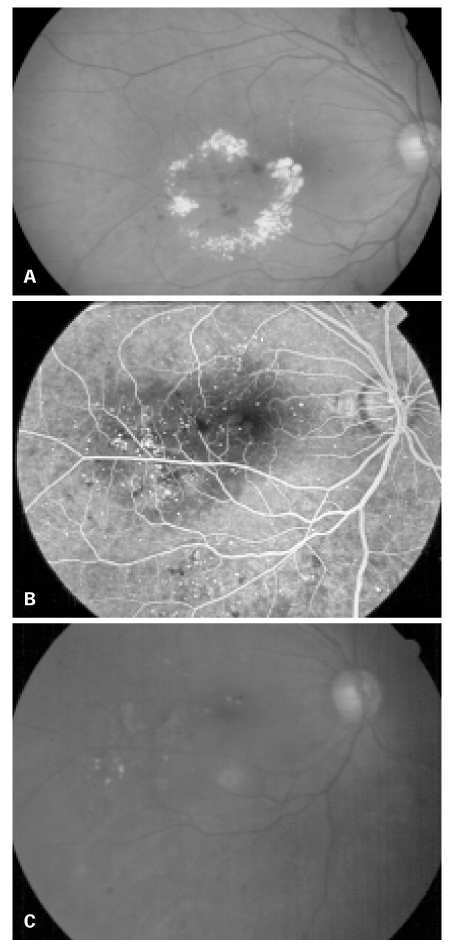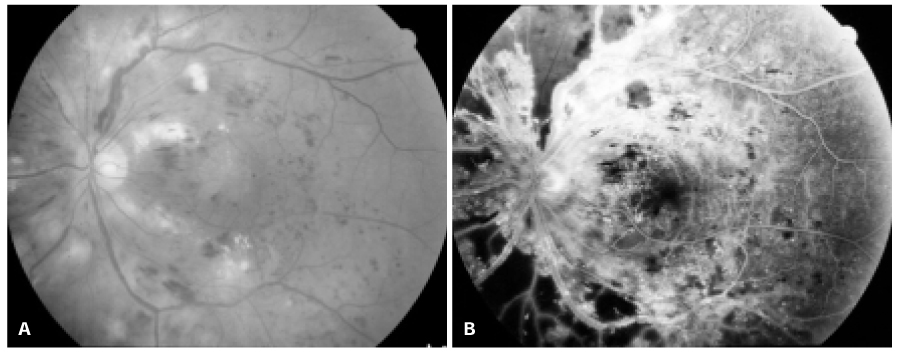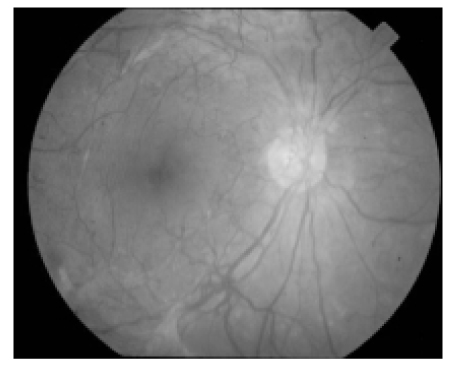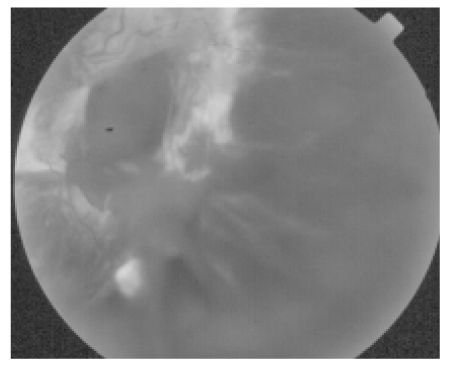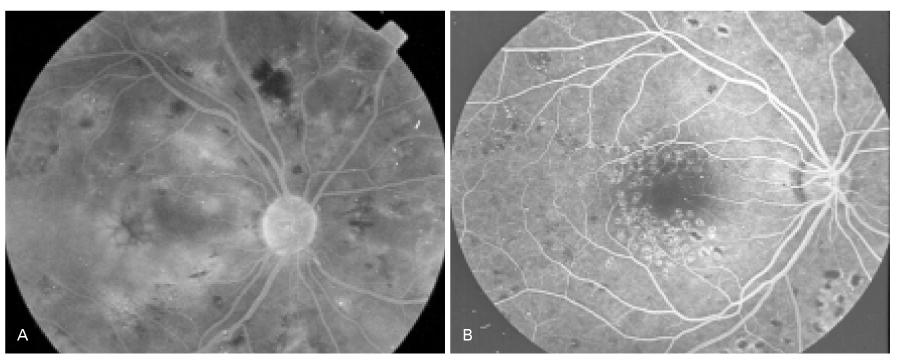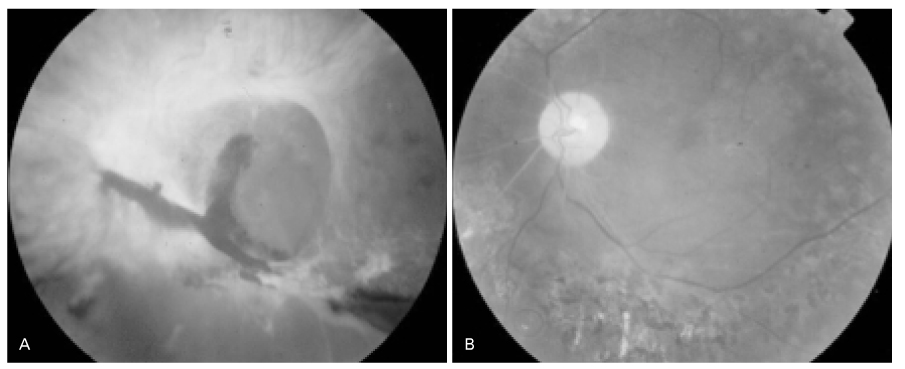J Korean Med Assoc.
2005 Jul;48(7):616-627. 10.5124/jkma.2005.48.7.616.
Diabetic Retinopathy
- Affiliations
-
- 1Department of Ophthalmology, The Catholic University of Korea College of Medicine, Kangnam St. Mary's Hospital, Korea. wklee@catholic.ac.kr
- KMID: 2183586
- DOI: http://doi.org/10.5124/jkma.2005.48.7.616
Abstract
- Retinopathy is the most common and vision threatening ocular complication of diabetes mellitus. Epidemiologic studies have described the natural history of diabetic retinopathy, and several well-designed clinical studies have demonstrated the benefits of laser photocoagulation, vitrectomy and tight metabolic control. New therapeutic trials are in progress. But it is one of the major causes of blindness in the adult population, which suggest the importance of early diagnosis and careful follow up examination as well as proper treatment in time.
Keyword
MeSH Terms
Figure
Cited by 1 articles
-
Risk Factor Analysis of Diabetic Retinopathy Diagnosed with Non-mydriatic Fundus Camera: KNHANES V
Jung Suk Yoon, Seung-Kook Baek, Young Hoon Lee
J Korean Ophthalmol Soc. 2019;60(6):555-568. doi: 10.3341/jkos.2019.60.6.555.
Reference
-
1. Roy MS, Klein R, O'Colmain BJ, Klein BE, Moss SE, Kempen JH. The prevalence of diabetic retinopathy among adult type 1 diabetic persons in the United States. Arch Ophthalmol. 2004. 122:546–551.
Article2. Kempen JH, O'Colmain BJ, Leske MC, Haffner SM, Klein R, Hamman RF, et al. The prevalence of diabetic retinopathy among adults in the United States. Arch Ophthalmol. 2004. 122:552–563.
Article3. Klein R, Klein BE, Moss SE, Cruickshanks KJ. The Wisconsin Epidemiologic Study of Diabetic Retinopathy: XVII. The 14-year incidence and progression of diabetic retinopathy and associated risk factors in type 1 diabetes. Ophthalmology. 1998. 105:1801–1815.
Article4. The Early Treatment Diabetic Retinopathy Study Research Group. Fundus photographic risk factors for progression of diabetic retinopathy. Early treatment diabetic retinopathy study report No 12. Ophthalmology. 1991. 98:807–822.5. The Diabetic Retinopathy Study Research Group. Four risk factors for severe visual loss in diabetic retinopathy. The third report from the DRS. Arch Ophthalmol. 1979. 97:654–655.6. Early Treatment Dabetic Retinopathy Study Report Number 19: Focal photocoagulation treatment of diabetic macular edema. Arch Ophthalmol. 1995. 113:1144–1155.7. The Diabetes Control and Complications Trial Research Group. The effect of intensive diabetes treatment on the progression of diabetic retinopathy in insulin-dependent diabetes mellitus. Arch Ophthalmol. 1995. 113:36–51.8. The Diabetes Control and Complications Trial Research Group. The effect of intensive treatment of diabetes on the development and progression of long-term complications in insulin-dependent diabetes mellitus. N Eng J Med. 1993. 329:977–986.9. Sutter FK, Simpson JM, Gillies MC. Intravitreal triamcinolone for diabetic macular edema that persists after laser treatment: three-month efficacy and safety results of a prospective, randomized, double-masked, placebo-controlled clinical trial. Ophthalmology. 2004. 111:2044–2049.
Article10. The Diabetic Retinopathy Study Research Group. Photocoagulation treatment of proliferative diabetic retinopathy. Clinical applications of DRS findings. DRS report No 8. Ophthalmology. 1981. 88:583–600.11. The Early Treatment Diabetic Retinopathy Study Research Group. Early photocoagulation for diabetic retinopathy. Early treatment diabetic retinopathy study report No 9. Ophthalmology. 1991. 98:766–785.
- Full Text Links
- Actions
-
Cited
- CITED
-
- Close
- Share
- Similar articles
-
- The Influences of Arteriosclerosis on the Development and Progression of Diabetic Retinopathy
- Clinical Review on Diabetic Retinopathy
- Changes of ERG Parameters in Diabetic Retinopathy
- Photopic Flash ERG Changes in Diabetic Retinopathy: with reference to severity of diabetic retinopathy
- The Relationship between Diabetic Retinopathy and Corneal Autofluorescence


